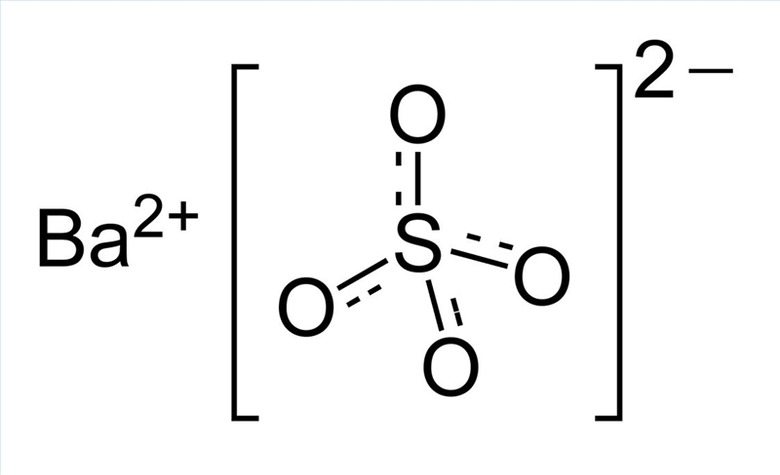Physical Properties Of Barium Sulfate
Barium is a soft, reactive, silvery-white, alkaline earth metal, somewhat resembling metallic calcium. Sir Humphry Davy first isolated it in 1808. The periodic table lists the alkaline earth metals from lightest to heaviest as beryllium, magnesium, calcium, strontium and barium.
Barium sulfate, BaSO₄, is one of the most water-insoluble compounds known. You can prepare it through double-displacement reactions such as the following:
Na₂SO₄ + BaCl₂ ' BaSO₄↓ + 2 NaCl
Barium sulfate is remarkably stable and cannot be converted to something else using this sort of reaction.
Bulk Properties
Bulk Properties
Barium sulfate is white to pale yellow in color and is nonflammable, with a melting point of 1,580 degrees Celsius. It possesses an unusually high specific gravity of 4.25 to 4.50, resulting in its name, taken from the Greek "barys," meaning "heavy."
Particle Properties
Particle Properties
Particles of barium sulfate are considered inert, so in cases of inhalation, it is labeled as a "nuisance dust." In addition, barium particles do not possess a large surface area. This makes it useful for quick flow-through catalytic reactions employing partially deactivated palladium (called Lindlar's catalyst).
Chemical Properties
Chemical Properties
In general, barium salts are quite water-soluble. In solution, the compounds dissociate to form very toxic barium +2 ions. Since barium sulfate does not dissolve in water, no such ions form.
Use in Radiology
Use in Radiology
Since the barium atom is large and heavy, it absorbs X-rays quite well. Since the sulfate also possesses no toxicity, it is used as a radio-opaque or radio-contrast agent in gastrointestinal testing. A barium "milkshake" or "meal," a drinkable aqueous suspension, is consumed gradually, beginning 90 minutes to two hours before testing begins. Side effects may include nausea, diarrhea and headache.
Other Uses
Other Uses
Barium sulfate is used in oil-drilling mud, textiles, pigments, photographic papers, ceramics and glasses, artificial ivory, and battery plate pastes.
Hazards
Hazards
Although definitely stable and safe for ordinary use, barium sulfate can react explosively if mixed with aluminum and heated. In a fire, barium sulfate generates toxic sulfur oxides. If improperly made, such as in a famous 2003 incident in Brazil, it can cause death. This incident stemmed from illegal preparation, resulting in contamination by the water-soluble carbonate.
Cite This Article
MLA
Summers, Vincent. "Physical Properties Of Barium Sulfate" sciencing.com, https://www.sciencing.com/physical-properties-barium-sulfate-5420946/. 24 April 2017.
APA
Summers, Vincent. (2017, April 24). Physical Properties Of Barium Sulfate. sciencing.com. Retrieved from https://www.sciencing.com/physical-properties-barium-sulfate-5420946/
Chicago
Summers, Vincent. Physical Properties Of Barium Sulfate last modified March 24, 2022. https://www.sciencing.com/physical-properties-barium-sulfate-5420946/
